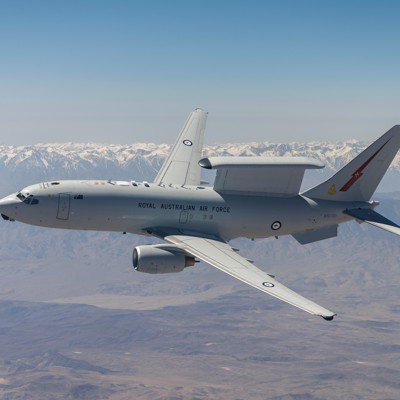Funding for the Air Force’s new E-7 Wedgetail radar jet was included in the bipartisan agreement on Sunday evening to end the longest-ever government shutdown—despite the fact that the military wants to gut the program.
Tucked into the 31-page continuing resolution agreement that would fund the government through January is a nearly $200 million spending exception for “continued rapid prototyping activities to maintain program schedule and transition to production” of the Air Force’s E-7 program. Similar efforts to fund the early warning and control aircraft were included in versions of the National Defense Authorization Act and Defense Appropriations Act this summer, as well as a stopgap funding bill in September.
“Other programs will be funded through January 30th, while the Senate and House continue work on the remainder of the year-long appropriations bills,” Sen. Susan Collins, a Maine Republican and Senate Appropriations Committee chair, said Sunday. “I look forward to voting for this legislation and ending the unnecessary harm to the security of our families and our nation.”
While several procedural hurdles remain before Sunday’s agreement is finalized, the inclusion of the E-7 in the continuing resolution marks a win for Boeing, which makes the Wedgetail.
However, a company spokesperson declined to comment on the latest measure. The Air Force did not return a request for comment.
The Congressional support for the radar plane more than 40 days into the government shutdown is at odds with Defense Secretary Pete Hegseth’s criticism of the E-7’s survivability and the Air Force’s 2026 budget request axing funding for the program. While officials have pointed to investments in space-based capabilities for intelligence, surveillance, and reconnaissance instead, defense experts said the inclusion of the Wedgetail shows lawmakers are concerned about the Space Force getting its Airborne Moving-Target Indication systems up and running quickly.
“If it passes, this is a big win for Boeing, and it shows that many in Congress still have doubts about how quickly the Space Force can deploy the AMTI system it funded in the reconciliation bill a few months ago,” said Todd Harrison, a defense budget expert with the American Enterprise Institute think tank. “This is Congress hedging its bets on the airborne warning mission.”
Hegseth told Congressional appropriators this summer that the E-7 was an example of a platform that was “not survivable in the modern battlefield or they don’t give us an advantage in a future fight.” Additionally, defense officials this summer said the program was going to be cut “due to significant delays with cost increases.”
The E-7 was pitched as a replacement for the service’s aging E-3 Sentry aircraft. Boeing and the Air Force reached an agreement last year for two test planes, to be delivered in 2028 for a substantial $2.6 billion, the service previously announced. Those costs have risen by $884 million, a 33 percent increase, according to a June Government Accountability Office report.
In September, the British government announced that those two E-7 prototypes will be built in the United Kingdom.
Read the full article here








Leave a Reply